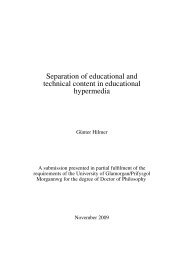framework for the implementation of a virtual design studio model in ...
framework for the implementation of a virtual design studio model in ...
framework for the implementation of a virtual design studio model in ...
You also want an ePaper? Increase the reach of your titles
YUMPU automatically turns print PDFs into web optimized ePapers that Google loves.
The use <strong>of</strong> metaphor is also considered as a way <strong>for</strong> <strong>in</strong>spiration. As all<br />
metaphors are juxtapositions, which means that two th<strong>in</strong>gs are put<br />
toge<strong>the</strong>r to f<strong>in</strong>d <strong>the</strong>ir shared characteristics. Any metaphor, <strong>the</strong>re<strong>for</strong>e,<br />
triggers new ways <strong>of</strong> th<strong>in</strong>k<strong>in</strong>g which encourages <strong>in</strong>spiration and <strong>in</strong> turn<br />
encourages creative th<strong>in</strong>k<strong>in</strong>g.<br />
Shank and Gleber 199 state that juxtaposition<strong>in</strong>g encourages<br />
bra<strong>in</strong>storm<strong>in</strong>g:<br />
“The human m<strong>in</strong>d cannot tolerate a mean<strong>in</strong>g vacuum. If we compare<br />
some X to Y, <strong>the</strong>n we strive mightily to understand that comparison.<br />
Sometimes <strong>the</strong> comparison is simple and transparent. When we<br />
compare, say, a smile to a flower, <strong>the</strong>n it is easy to abduct that <strong>the</strong> smile<br />
is pretty and pleasant, much as a flower is pretty and pleasant. When<br />
we make such simple abductions, <strong>the</strong>n we are stay<strong>in</strong>g well with<strong>in</strong> our<br />
current 11 range <strong>of</strong> preconceptions about <strong>the</strong> mean<strong>in</strong>g <strong>of</strong> th<strong>in</strong>gs <strong>in</strong> <strong>the</strong><br />
world. When our metaphors are arbitrary, however, <strong>the</strong>n we are no<br />
longer <strong>in</strong> “safe” preconceptual territory. There is no easy and apparent<br />
solution to <strong>the</strong> metaphor “puzzle”. Also, even though we know that <strong>the</strong><br />
comparison is arbitrary, we still feel <strong>the</strong> tug <strong>of</strong> our desire to render <strong>the</strong><br />
comparison as mean<strong>in</strong>gful. There<strong>for</strong>e, we have no choice but to leave<br />
our familiar preconceptions and engage <strong>in</strong> mean<strong>in</strong>g exploration”. 200<br />
In academia <strong>the</strong>re are arguments if creativity is someth<strong>in</strong>g that can be<br />
taught to student. Many researchers believe that creativity can be<br />
acquired through learn<strong>in</strong>g only if <strong>the</strong>re is an adequate place <strong>for</strong> it <strong>in</strong> <strong>the</strong><br />
curricula.<br />
Casak<strong>in</strong> 201 conducted a study to assess <strong>the</strong> use <strong>of</strong> metaphor <strong>in</strong> creative<br />
problem-solv<strong>in</strong>g <strong>in</strong> <strong>the</strong> context <strong>of</strong> first year <strong>design</strong> <strong>studio</strong> students.<br />
Casak<strong>in</strong> argues that <strong>the</strong>se tools are very important <strong>for</strong> <strong>the</strong> student <strong>in</strong><br />
<strong>the</strong>ir first year to overcome <strong>the</strong>ir lack <strong>of</strong> experience <strong>in</strong> <strong>design</strong> problems,<br />
and concludes that<br />
199 Shank G., Gleber C. (2001). Six Metaphors <strong>in</strong> Search <strong>of</strong> <strong>the</strong> Internet. (Accessed March 22, 2010).<br />
200 Ibid. p4.<br />
201 Casak<strong>in</strong> H. P. (2007). op.cit. p22-33.<br />
65



